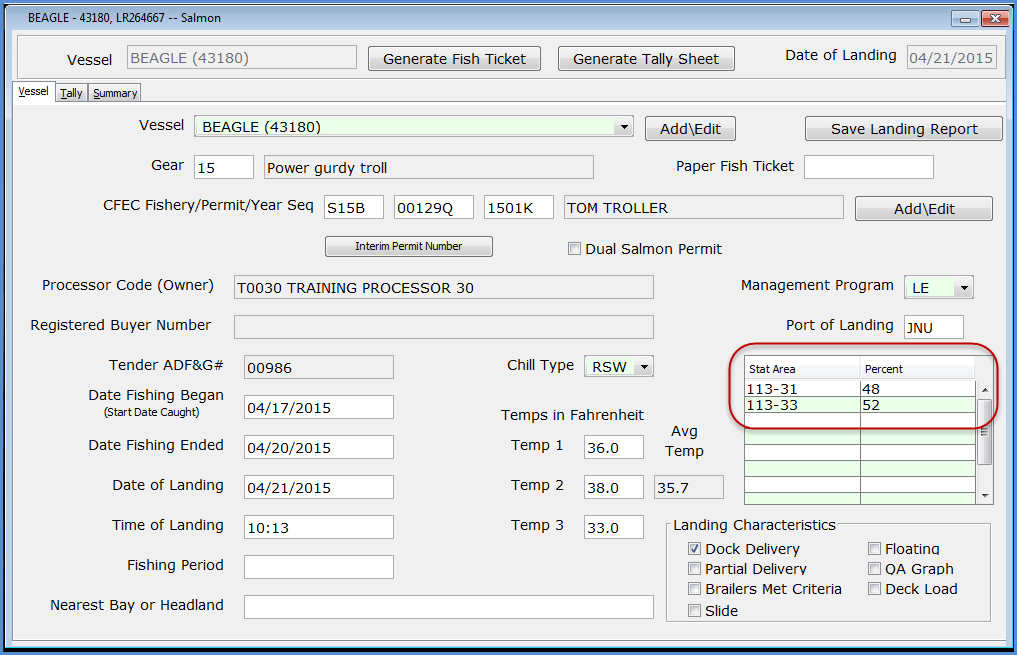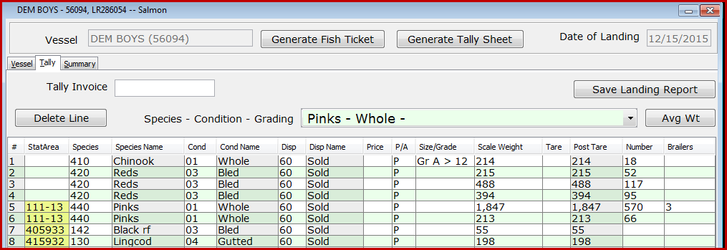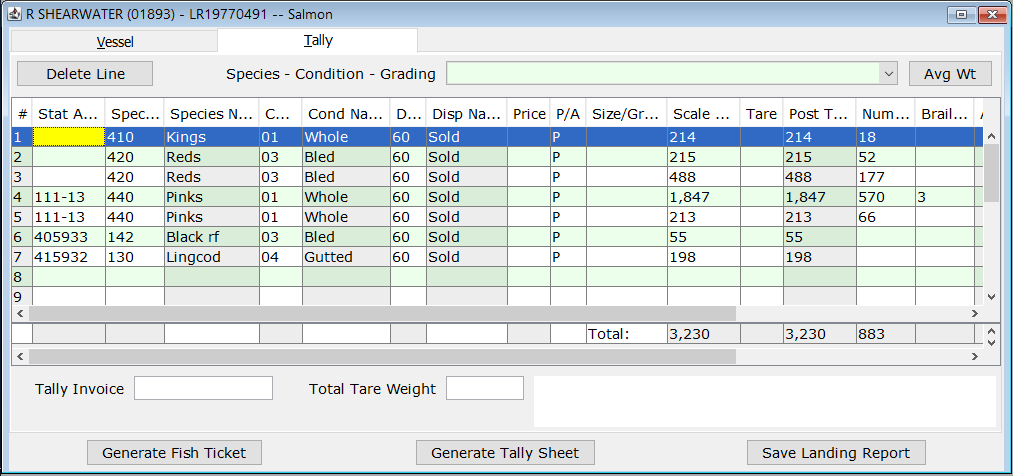tend
| Table of Contents | ||
|---|---|---|
|
...
- ADF&G Vessel Number: this is the five digit number permanently assigned by the Commercial Fishery Entry Commission (CFEC).
- ADF&G Gear Code: this is the two digit numeric code used to identify the gear used to harvest the catch. These gear codes can be viewed by clicking on the Gear Codes link. For salmon troll this will be either 15 for Power Troll or 05 for Hand Troll.
- Date Fishing Began: when the gear was deployed in the water to begin fishing.
- Date Fishing Ended: when the gear was taken out of the water.
- Days Fished: when the gear was being fished. This number does not include traveling to and from the fishing grounds, or weather delays.
- Date of Landing: when the landing was completed.
- Entered From Paper FT: If you are entering a paper fish ticket into eLandings or a ticket from tLandings that was unable to upload into eLandings, please enter the paper fish ticket number (i.e., E18 123456) so that the two fish tickets can be associated together. For more information please see Entering Paper Fish Tickets into eLandings.
- Port of Landing: location where the landing occurred. This value is auto-filled from your User Agreement registration. You can modify this value to indicate the correct location for this landing. You can click on the Port Codes link under the Port of Landing area for a list of port codes.
- Nearest Bay or Headland: Site description of where fishing actually occurred designated by the nearest bay or headland's name. Example designations are "Icy Point" or "Cape Cross". If you have a question please ask your local area ADF&G office.
- Partial Delivery: check if, Yes, the vessel has made deliveries to other operations or processors from this fishing trip, in other words, deliveries elsewhere, or if the delivery to your operation is only a portion of the catch.
- If you created more than one landing report for a delivery, you should also check the PartialDelivery box, to indicate Yes.
- ADF&G Processor Code: the owner of the product that has just been purchased - the purchaser. This value is auto-filled from your User Agreement registration. This value is auto-filled from your User Agreement registration. Select the correct number if one than one RCR is associated with your User Agreement.
- ADF&G Processor Code (Custom Processor): applicable only if the product is being received or processed by a third party - not the purchaser.
- Chill Type: Refrigeration system used to keep fish cold in the vessel hold. It is generally used in conjunction with Temperature. This is a courtesy field provided to Processors at their request to help track quality of catch. This is not a required field.
- Temperature (in F): Temperature in degrees fahrenheit. This is a courtesy field provided to Processors at their request to help track quality of catch. This is not a required field.
tLandings Only Worksheet
If you are editing a ticket that has been created using tLandings or entering a paper fish ticket you will need to fill in or ensure the validity of the following fields:
- Time of Landing: The time fish or shellfish are off-loaded or trans-shipped from the catcher vessel to the first purchaser. The time of landing is the day off-load is completed. For catcher-processors the time landed is the time the product is caught and brought on board. For catcher-seller vessels the land date time is the time the product is initially brought into port.
- Tender ADF&G vessel number: The ADF&G vessel number assigned to an acting tender vessel. A tender is a vessel that is attendant to other vessels and is used to transport or ferry unprocessed fish or shellfish received from another vessel to a shoreside processor or mothership. Tender vessels operate, in most circumstances, as an agent for a specific processor and take deliveries from harvesting vessels.
- Tender Batch: Is the batch number assigned by the processor user when uploading a batch of tickets from tLandings/PTI to eLandings.
- Tally Invoice: Tally sheet is provided in tLandings and provides a summary of all items recorded in a landing.
CFEC & IFQ Permit Worksheets
...
- Complete the required information on the Vessel page in tLandings, including the five-digit statistical area(s) and percentage of salmon harvest in the Stat Area Worksheet.
- On the Tally page, report each salmon species in the itemized catch section by condition, disposition, price and size/grade, weight, and number. If the stat area of catch for a particular species differs from that detailed in the Stat Area Worksheet, report the individual stat area with that species in the itemized catch section.
- The tLandings program now requires the documentation of groundfish statistical areas within the application. In the itemized catch section, enter the six-digit groundfish statistical area(s) for each groundfish species. Groundfish statistical area information should be collected from the permit holder at the time of landing. Report each groundfish species by condition, disposition, price and size/grade, and weight. Tender operators do not need to document the number of fish when reporting groundfish; groundfish harvest reporting requirements are restricted to pounds.
- Save, print and sign the fish ticket. Fish tickets must be signed by the permit holder and the buyer.An imprint of the S15B or S05B CFEC card is required if a magnetic stripe reader was not used.
Processors Using Conventional ADF&G Fish Tickets
...



